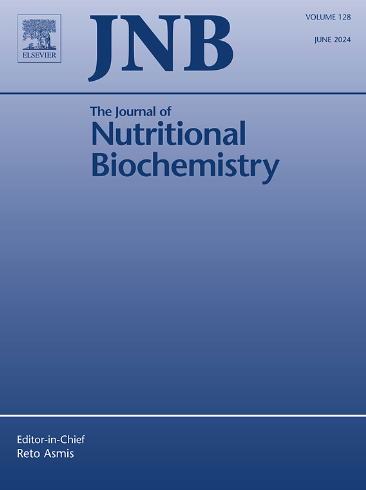Early overfeeding and adult anhedonia: Impact of neonatal nutrition on hedonic food regulation in male rats
IF 4.9
2区 医学
Q1 BIOCHEMISTRY & MOLECULAR BIOLOGY
引用次数: 0
Abstract
The aim of our study was to analyze the impact of early-life overnutrition and the exposure in adulthood to a cafeteria diet (CAF) on eating behavior and on the expression of key genes involved in the regulation of food intake. Male Wistar rats were raised in small (SL, 4 pups/dam) or normal litters (NL, 10 pups/dam), fed a control diet (CON) until postnatal day (PND) 90. Then, they received CON or CAF for 11 weeks (NL-CON, NL-CAF, SL-CON, SL-CAF; 12±2 rats/group). Body weight, food intake and behavioral tests (Elevated Plus Maze: EPM, Sensory-specific satiety: SSS) were assessed. At PND167, the rats were euthanized to obtain brain, blood and fat pads. Ventral tegmental area (VTA), Nucleus Accumbens (NAc) and Arcuate Nucleus (Arc), were isolated by micropunch technique for qPCR analysis. Early overfeeding alone had the ability to alter long-term SSS. CAF groups showed increased body weight, adiposity and energy intake; sweet food preference and altered SSS. SL-CAF showed hypophagia, basal hyperglycemia, altered SSS and anxiety-like behavior. Both NL-CAF and SL-CAF showed antidopaminergic effects, but through different pathways: NL-CAF reduced dopamine (DA) production in VTA via decreased tyrosine hydroxylase (TH) expression, while SL-CAF exhibited an increase in dopamine active transporter (DAT) expression in NAc enhancing clearance. SL decreased Neuropeptide Y (NPY) expression in the Arc in adulthood, which has been proposed to be the link between homeostatic and hedonic systems. Our research reveals a key link between early-life overnutrition and adult hedonic feeding control, emphasizing its lasting impact on eating behavior and the potential for innovative therapeutics to combat obesity.

早期过度喂养和成年快感缺乏:新生儿营养对雄性大鼠享乐性食物调节的影响。
我们研究的目的是分析早期营养过剩和成年后接触自助餐厅饮食(CAF)对饮食行为和参与调节食物摄入的关键基因表达的影响。雄性Wistar大鼠按小窝(SL, 4只/坝)或正常窝(NL, 10只/坝)饲养,饲喂对照日粮(CON)至出生后(PND) 90。然后给予CON或CAF治疗11周(NL-CON、NL-CAF、SL-CON、SL-CAF;12±2鼠/组)。评估体重、食物摄入量和行为测试(升高+迷宫:EPM,感觉特异性饱腹感:SSS)。在PND167,对大鼠实施安乐死以获得脑、血液和脂肪垫。采用微孔技术分离出腹侧被盖区(VTA)、伏隔核(NAc)和弓形核(Arc),进行qPCR分析。早期的过度喂养能够改变长期的SSS。CAF组小鼠体重、脂肪和能量摄入增加;甜食偏好与SSS的改变。SL-CAF表现为嗜食、基础高血糖、SSS改变和焦虑样行为。NL-CAF和SL-CAF均表现出抗多巴胺能作用,但其途径不同:NL-CAF通过降低酪氨酸羟化酶表达来减少VTA中多巴胺(DA)的产生,而SL-CAF通过增加NAc中多巴胺活性转运蛋白表达来增强清除。成年后,SL降低了Arc中NPY的表达,这被认为是体内平衡和享乐系统之间的联系。我们的研究揭示了早期营养过剩与成人享乐性喂养控制之间的关键联系,强调了其对饮食行为的持久影响以及对抗肥胖的创新疗法的潜力。
本文章由计算机程序翻译,如有差异,请以英文原文为准。
求助全文
约1分钟内获得全文
求助全文
来源期刊

Journal of Nutritional Biochemistry
医学-生化与分子生物学
CiteScore
9.50
自引率
3.60%
发文量
237
审稿时长
68 days
期刊介绍:
Devoted to advancements in nutritional sciences, The Journal of Nutritional Biochemistry presents experimental nutrition research as it relates to: biochemistry, molecular biology, toxicology, or physiology.
Rigorous reviews by an international editorial board of distinguished scientists ensure publication of the most current and key research being conducted in nutrition at the cellular, animal and human level. In addition to its monthly features of critical reviews and research articles, The Journal of Nutritional Biochemistry also periodically publishes emerging issues, experimental methods, and other types of articles.
 求助内容:
求助内容: 应助结果提醒方式:
应助结果提醒方式:


